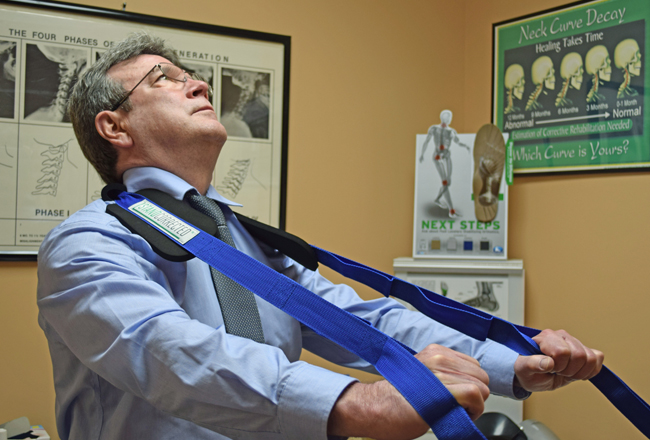According to a recent study, Americans spend an average of five hours each day looking down at a mobile device, whether scrolling through social media, surfing the web or trying to beat a level of Candy Crush.
While many have felt the effects of these prolonged periods of poor posture in the form of stiff necks or sore shoulders, the long-term damage could be far more serious.
“I”™ve treated many, many people suffering from painful neck, back and shoulder problems due to poor posture, frequently caused by the overuse of these tech devices,” said Tom Carpenter, a chiropractor in Yorktown Heights who has been in practice for more than 30 years. “Everybody is looking down at their phone all the time, and they”™re ruining their necks.”
A human head weighs roughly 11 pounds. According to research published in Surgical Technology International, when the head tilts forward, it puts increased pressure on the neck. A 15 degree forward tilt can increase the strain on the neck to 27 pounds, while a 60 degree forward tilt increases that weight to 60 pounds. This strain, commonly referred to as “text neck,” also puts pressure on the spine and supporting muscles, tendons and ligaments. This forward head posture could also lead to long-term muscle strain, disc herniations, arthritis and pinched nerves.
“This is a common problem for people that”™s caused by looking down too much. It”™s like putting on a five-pound hat and walking around with it all day long,” said Carpenter, who is also a certified personal trainer and corrective exercise specialist. “It”™s not good for you.”

To help remedy those issues, Carpenter has developed Stand Corrected, a device that he says can help reverse damage cause by years of poor posture.
His invention is a portable, lightweight, harness-like stretching tool that uses the weight of a person”™s arms to provide a stretch that elongates muscles and can reduce pain.
The long strap includes a foam tube that is placed at the back of the neck to encourage a healthy cervical curve. The straps and pads are then draped over the front of the shoulders, and the users hands are slipped into the loops along the straps, which can then be lifted behind the back to provide a stretch.
Carpenter said the device can provide relief almost instantly and takes just minutes per day to have a positive effect on posture.
“You can just start with just 5 to 10 seconds, then wait a day and see how you feel,” he said. “You don”™t have to go any longer than half a minute.”
The device could also be used by musicians who hunch over their instruments, dentists or massage therapists who lean over patients, gardeners bending over to dig dirt or even those who spend their free time knitting or crocheting.
[vsw id=”IyCe3NQCWk4″ source=”youtube” width=”650″ height=”440″ autoplay=”no”]Stand Corrected has proven to be so popular that last year, Carpenter decided to broaden its reach. He recently signed a deal with e-retailers to offer the product through websites including Walmart, Sears, Kmart and Amazon.
“It”™s looking very promising right now,” Carpenter said of his invention”™s future.
Carpenter said that while there are a number of products available for health care practitioners on the market, “they just weren”™t enough.”
“I could never find one that was able to simultaneously stretch the neck and shoulders back, encourage the normal 40 degree forward curve of the neck, correct upper body posture in general, and at the same time, also be portable, easy to use, effective and inexpensive,” he said.
Carpenter came up with the idea 4 years ago after using a Stretch Out Strap, an assisted stretching tool often used by his personal training clients.
“If I tried to just use a strap to stretch my upper body, it wasn”™t very comfortable, but it also didn”™t grab enough of the shoulder to pull it back,” he recalled. “I said to myself, ”˜I wonder if I took a tube and put this strap down inside of it, if I could create something better.”™”
Drawing upon his skills in fabric and design, skills he honed as the owner of a furniture upholstery shop prior to embarking on his career as a chiropractor, Carpenter decided to create something new. He added two foam shoulder pads to his design, which are both removable and adjustable using fastening strips.
“I was making them at my kitchen table,” he recalled.
Carpenter soon began bringing his inventions into his office for some of his patients.
“They started really liking it,” he said. “They didn”™t have to just wait to come to see me. They could use these at home.”
To help bring awareness to both his invention and the issues that can be caused by “text neck,” Carpenter is in the midst of a marketing push and recently embarked on a new social media campaign.
“Sales are picking up,” he said. “We”™re very optimistic.”



















